The Allure of Valuable Arrowheads: A Comprehensive Exploration


Intro
As we tread through history, few artifacts evoke the same sense of intrigue and wonder as arrowheads. These small but significant items, often buried beneath layers of earth, whisper tales of ancient civilizations and their remarkable craftsmanship. Many of these arrowheads are not just relics; they hold immense value due to their historical importance and the skill involved in their creation.
Understanding the allure of valuable arrowheads involves a deeper look into their history and origins, the various types that exist, and the factors that contribute to their worth. For collectors, both seasoned and novice, gaining insight into this fascinating world enhances the experience of searching for and collecting these pieces of history.
The journey begins with understanding where these artifacts come from and the cultural significance they embody. Knowing the history behind these arrowheads can enrich the collector's perspective and appreciation, turning a simple hobby into a meaningful pursuit.
Moreover, spotting genuine craftsmanship and determining the value of an arrowhead requires an informed eye. This article aims to be a invaluable resource, shedding light on the identification, classification, and dynamics of the arrowhead collecting market. Let’s dive into the heart of the matter.
Prelims to Valuable Arrowheads
The allure surrounding valuable arrowheads captivates collectors and historians alike, intertwining threads of culture, craftsmanship, and history. This introduction sets the stage for exploring the intricate world of arrowheads, emphasizing their significance not just as artifacts, but as vessels of ancient stories. Valuable arrowheads, often made with care and precision, stand as testament to the skills of their creators and the technological advancements of their time. Understanding their value involves deep engagement with various elements such as their materials, designs, and the narratives they embody.
Defining Valuable Arrowheads
Defining what makes an arrowhead valuable delves deeper than surface observations. It’s essential to consider several factors. First, the material used often speaks volumes; materials like obsidian or flint can be more prized than simple stone due to their rarity and crafting intricacies. Next is the craftsmanship; arrowheads that showcase superior skill in shaping or flaking exhibit historical value that resonates with collectors. Lastly, the context of discovery, whether an archaeological site or a personal collection passed down through generations, contributes to an arrowhead’s story and perceived worth.
Significance in Collecting
In the realm of collecting, arrowheads cannot be merely reduced to their monetary value; they represent connections to our human past. For many enthusiasts, collecting arrowheads transforms into a passionate pursuit of history. Ownership of a valuable arrowhead can create a tangible link to ancient peoples, invigorating curiosity about their lifestyles and cultures. Many collectors find that belonging to a network of similar-minded individuals enhances their experience, blending personal satisfaction with communal knowledge sharing.
"Valuable arrowheads are not just pieces of history; they are gateways to understanding the specifics of human ingenuity and adaptation through time."
Moreover, the thrill of discovery—whether through attending local shows or sifting through old family belongings—adds an element of adventure to the collecting journey. The importance of provenance, or the history of an arrowhead, often plays a crucial role in its allure, making the quest for each piece not merely about possession but also about the stories they carry.
Historical Context
Understanding the historical context of arrowheads enriches the appreciation of their value both as artifacts and collectibles. Arrowheads are not merely tools; they are windows into bygone eras, encapsulating stories of our ancestors and their interactions with the environment. They tell us about the lifestyles of ancient cultures, shedding light on hunting practices, trade routes, and even social structures. As each region developed distinct styles and materials, arrowheads became a medium for cultural expression, reflecting the ingenuity and adaptability of various communities.
Cultural Importance of Arrowheads
Arrowheads hold significant cultural weight across numerous societies, often seen as symbols of survival and adeptness. For Indigenous peoples of North America, arrowheads represent more than functional tools; they embody centuries of tradition, spirituality, and identity. Different tribes crafted arrowheads using local materials, resulting in regional variations that converse with narratives of land and resource use. For instance, the adaptiveness of the Plains tribes can be seen in their finely crafted projectile points made of chipped flint, perfectly tailored for hunting bison, demonstrating skilled craftsmanship honed over generations.
"Arrowheads can tell us much about the people who created and used them, beyond their utility."
These artifacts also serve as educational resources, offering insights into the technological innovations of their time. Various methods of stone flaking, such as pressure flaking or direct percussion, marked advancements in tool-making and showcase the artistic finesse of their creators. Buyers and collectors often seek arrowheads for their beauty and the narratives they carry, thus preserving cultural legacies.
Technological Advances in Arrowhead Production
The production of arrowheads has evolved markedly over millennia, reflecting broader technological advancements. Initially, these tools were fashioned from stones like obsidian or quartz, prized for their sharp edges and strength. The ingenuity involved in creating these tools cannot be overstated; ancient artisans understood their materials deeply, mastering techniques to create effective hunting tools.
As time marched forward, advancements in metallurgy saw the introduction of metal arrowheads. Tribes began crafting arrowheads from copper and later, iron. These materials allowed for more durable tools but also changed hunting strategies and social dynamics. Metal introduced new efficiencies and versatility, altering not only how communities hunted but also how they traded and interacted with one another. The emergence of composite arrowheads—which combine various materials for improved performance—hinted at innovation fostered by necessity and creativity.
Examining these changes is fundamental for collectors, as the period of production and the techniques used can significantly affect an arrowhead's value. Understanding when an arrowhead was made, alongside the material utilized, adds layers to its assessment and appreciation, guiding collectors on their quests for unique and valuable pieces.
Types of Arrowheads
When it comes to arrowheads, understanding the various types is crucial for collectors and enthusiasts alike. Each type of arrowhead tells a story; they reveal the materials and methods used by different cultures throughout history. Dive into the different categories can open doors to not just collecting, but also appreciation of the artistry and function behind these tools. In this section, we will unpack the importance of Material Varieties and Regional Variations, each offering unique insights into the world of arrowheads.
Material Varieties
Stone
Stone arrowheads are often the most sought-after by collectors. They carry the weight of history and serve as a tangible connection to ancient peoples. Usually crafted from flint or obsidian, these materials exhibit the benefits of sharpness and resilience. The key characteristic of stone is its ability to be knapped, allowing artisans to shape and sharpen the edges precisely. This craftsmanship provides not only functionality but also aesthetic appeal, making stone arrowheads popular.
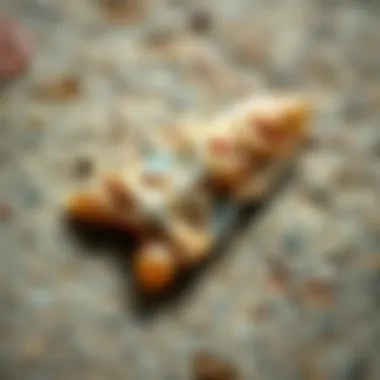
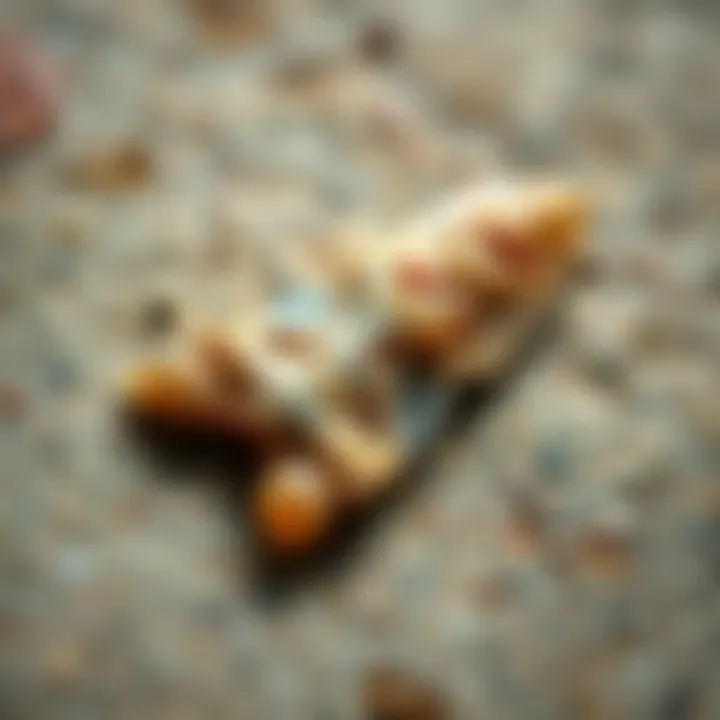
The unique feature of stone arrowheads is their ability to retain sharp edges longer than many other materials and the ease of creating intricate designs. However, they are also prone to chipping, which can diminish their value if not well-preserved. Careful handling and preservation techniques can help mitigate this.
Metal
Metal arrowheads have come into prominence, particularly with the advances in metallurgy. They are often favored for their durability and weight, which can impact an arrow’s flight dynamics positively. Commonly made from bronze, iron, or steel, metal arrowheads stand out due to their robustness. The key characteristic here is their ability to be mass-produced, making them accessible and varied.
A unique feature of metal arrowheads is their resistance to wear and tear, which allows for long-term preservation. However, they can rust, especially if exposed to moisture. Proper cleaning and storage strategies are essential to maintain their condition.
Composite
Composite arrowheads are fascinating as they often combine materials like stone and metal, leading to hybrid forms that can enhance performance. These arrowheads are crafted with a mix of raw materials aimed at maximizing strength and minimizing weight. The key characteristic of composite arrowheads is their versatility in design, marrying the sharpness of stone with the resilience of metal.
A unique aspect of composite designs is their potential for customization. Collectors often find these types intriguing due to the diversity in features. However, they can be more complex to authenticate, making them potentially risky for inexperienced collectors. Each visit to a dealer or auction is an opportunity to learn about the intricacies of these fascinating pieces.
Regional Variations
Regional differences significantly influence arrowhead design and materials, reflecting the customs and resources of local peoples. Understanding these variations is fundamental for any serious collector, as they provide insight into historical practices and cultures, all contributing to the arrowheads’ value and appeal.
Eastern North America
Eastern North American arrowheads are known for their diverse styles and material use. The indigenous peoples of this area crafted arrowheads that often featured elaborate designs, reflecting their rich cultural narratives. Characteristically, these arrowheads were sometimes made from locally available materials like quartz and flint, which were readily accessible.
With their intricate shapes, these arrowheads often commanded high prices in the market, especially those that were found in good condition. However, the demand also means that fakes can be a concern, making authentication a critical component for collectors in this region.
Western North America
Arrowheads from Western North America differ significantly due to the diverse landscapes and cultural heritage. Here, the materials can range widely, including basalt and chert, which highlight the local geology. A defining feature is often their size and shape, tailored for specific hunting practices, such as those used for large game in the rugged terrains.
The advantage of these arrowheads lies in their adaptation to the environment and hunting needs. This regional style is not only functional but also an aesthetic reflection of the culture’s relationship with nature.
Mesoamerica
In Mesoamerica, arrowheads transitioned from functional tools to culturally significant artifacts, featuring varied designs that often incorporated spiritual symbolism. The materials ranged from obsidian to ceremonial bronze, showcasing advanced metallurgy. The distinctive styles of Mesoamerican arrowheads have led to a deeper narrative, often celebrated through carvings that depict their symbolic meanings.
The unique feature here lies in the blend of practicality and art, where the arrowhead serves more than just as a weapon, reflecting deep cultural beliefs. However, the complexity of these pieces can make them daunting as collectibles, requiring a solid understanding of historical context and authenticity verification.
Identifying Valuable Arrowheads
Identifying valuable arrowheads is critical in the realm of collecting, as it lays the foundation for discerning authenticity, historical significance, and market value. The world of collecting can often be a minefield, with forgeries and misconceptions lurking behind seemingly genuine artifacts. Thus, equipping oneself with the right knowledge about the traits that make an arrowhead stand out is essential for collectors.
Key Characteristics
Shape and Size
Shape and size are vital elements when assessing an arrowhead's value. Different cultures and time periods favored unique shapes, from the classic triangulated designs to more elaborate fluted styles. The size can indicate its intended use—larger arrowheads might have been designed for hunting larger game, while smaller variants were suited for smaller targets.
A notable characteristic is the proportionate symmetry often found in valuable arrowheads. A well-balanced piece reflects the craftsperson's skill, as it takes a steady hand and an eye for detail to create such precision. The appeal lies in the fact that collectors often seek out these aesthetically pleasing forms; understanding what makes a shape desirable can significantly enhance one’s collection.
However, size has its downsides too. Larger arrowheads can be cumbersome, and their rarity can sometimes drive up prices artificially. Some collectors prefer smaller, more intricate pieces that tell a story of artistry instead of brute function.
Craftsmanship
Craftsmanship speaks volumes about an arrowhead's origin and relevance. The intricacies of flaking patterns, visible tool marks, and even the finish can distinguish expertly made pieces from those hastily put together. High-quality craftsmanship, marked by meticulous flaking and articulate designs, often signifies a valuable arrowhead.
When collectors evaluate craftsmanship, they often look for the distinctive traits of specific cultures. For instance, arrowheads crafted by Native American artisans often exhibit remarkable attention to detail; these stylistic flourishes add character and cultural weight.
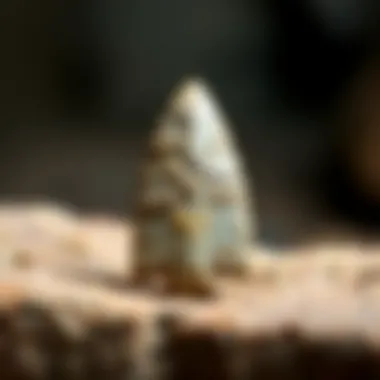
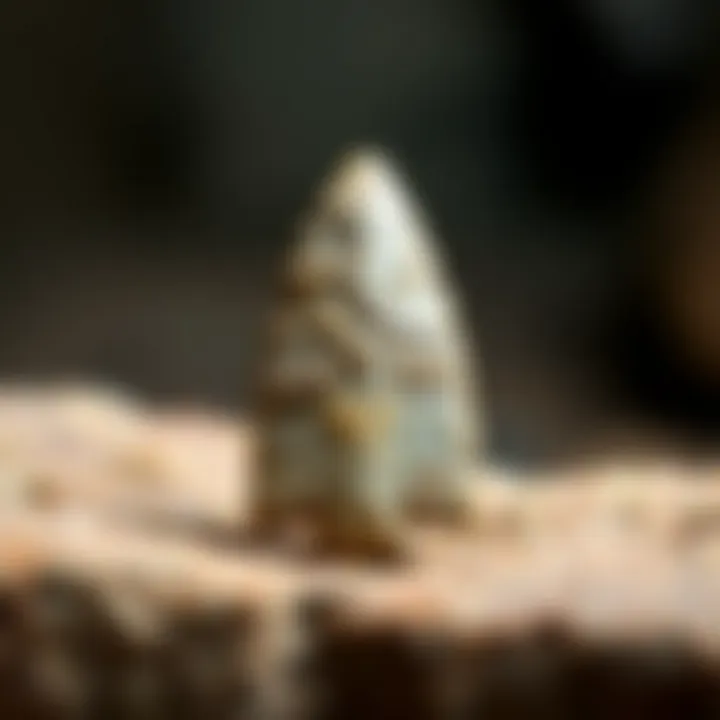
However, it’s essential to be cautious, as exceptional craftsmanship can sometimes lead to higher prices without a correlating increase in historical value. Understanding the nuances of craftsmanship is necessary for anyone serious about collecting valuable arrowheads.
Material Analysis
The material used to create an arrowhead is just as crucial as its shape and craftsmanship. Common materials include flint, obsidian, and other stone varieties, each imparting unique properties to the artifact. For instance, obsidian, with its glass-like quality, is prized for its sharpness but is also quite fragile. Collectors might prefer durable materials that withstand the test of time.
A key characteristic of a valuable arrowhead is its material type, as certain materials have become synonymous with specific time periods or cultures. Flints, especially those sourced from particular quarries, can fetch a higher price because of their historical relevance and availability. This makes material analysis a cornerstone of authenticity and value assessment.
The downside? The rarity of a particular material can cloud judgment. Some collectors may be swayed by glamour rather than substance. Hence, understanding the context behind each material can help avoid missteps in valuation.
Authentication Techniques
Visual Inspection
Visual inspection serves as the first line of defense in identifying valuable arrowheads. It involves scrutinizing the arrowhead for physical attributes such as patina, wear patterns, and any signs of tool marks. A seasoned collector can often spot the difference between a genuine piece and a replica by simply observing its surface.
A noteworthy feature here is the importance of knowing the typical wear patterns associated with each culture. Some arrowheads may exhibit signs of extensive use, while rarer examples may display a level of preservation hinting at their value. Collectors often rely on their intuition and experience during this phase; however, it holds its share of risks as well.
One major drawback is the potential for visual cues to be misleading. Without adequate knowledge, a collector might mistake a well-preserved artifact for a new replica, losing out on valuable finds.
Scientific Methods
Scientific methods of authentication offer a more rigorous approach to verifying an arrowhead's authenticity. These methods include techniques such as radiocarbon dating, chemical analysis, or even X-ray fluorescence to identify material composition. These scientific tools can quickly reveal the age and origin of an item, giving collectors a firmer foundation for their purchases.
One key advantage of scientific methods is the increase in accuracy they provide. Collectors can feel secure knowing that a thorough analysis corroborates their judgments. For example, determining the exact material composition verifies that the arrowhead aligns with a specific historical timeline or cultural crafting methodology.
However, such techniques aren't without drawbacks. They require specialized equipment and expertise, often making them costly and time-consuming. The lag time between questioning authenticity and obtaining solid results can leave some collectors in a lurch, unsure whether they made the right investment.
Market Dynamics
Understanding market dynamics is essential for anyone involved in the world of arrowhead collecting. This field may be niche, but it is rife with unique opportunities and challenges. The arrows of collecting are not just based on the physical pieces; they also revolve around the forces of supply, demand, and human connections. Grasping these dynamics can empower collectors to make informed decisions and enhance their experiences.
Auction Trends
Auctions serve as essential venues for the buying and selling of arrowheads. They not only reflect current market values but also influence them. Observing auction trends offers insights into what collectors are seeking. For instance, certain styles or materials might surge in popularity, spurring prices upward, while others may plateau or decline.
Collecting data from recent auctions shows that unique artifact provenance can drive significant interest and prices. Collectors often insist on knowing the story behind an arrowhead. A piece linked to a historical figure or event might fetch substantially higher bids. Additionally, auction houses often curate their offerings to highlight the most sought-after items, which can shift trends quickly.
"Understanding auction dynamics can offer insight into what items might appreciate in value in the future."
Some notable platforms hosting arrowhead auctions include:
- Heritage Auctions
- Skinner Auctioneers
- Bonhams
Among avid collectors, it’s common to follow these trends closely, comparing results from different houses. This practice supports the formulation of a strategic approach when considering purchase opportunities.
Online Sales Platforms
In the age of technology, online sales platforms have become a game-changer for collectors. Websites such as eBay, Etsy, and specialized collecting sites provide an expansive marketplace for arrowheads. Here, sellers can reach a broader audience, while buyers have the advantage of comparing various offerings side by side.
The beauty of these platforms lies in their accessibility. Buyers can often sift through thousands of listings with just a few clicks. However, this convenience comes with its own pitfalls, such as the risks of misrepresented items or fraudulent sales. A keen understanding of the platform etiquette is essential. It helps buyers and sellers establish trust, which is crucial in a market like this where authenticity greatly affects value.
**Key features to consider:
**- Seller Ratings: Trustworthiness can often be gauged through previous user feedback.
- Return Policies: Knowing the terms regarding returns can safeguard against poor purchases.
- Detailed Descriptions: Artifacts with comprehensive details, including images and provenance, usually attract higher interest.

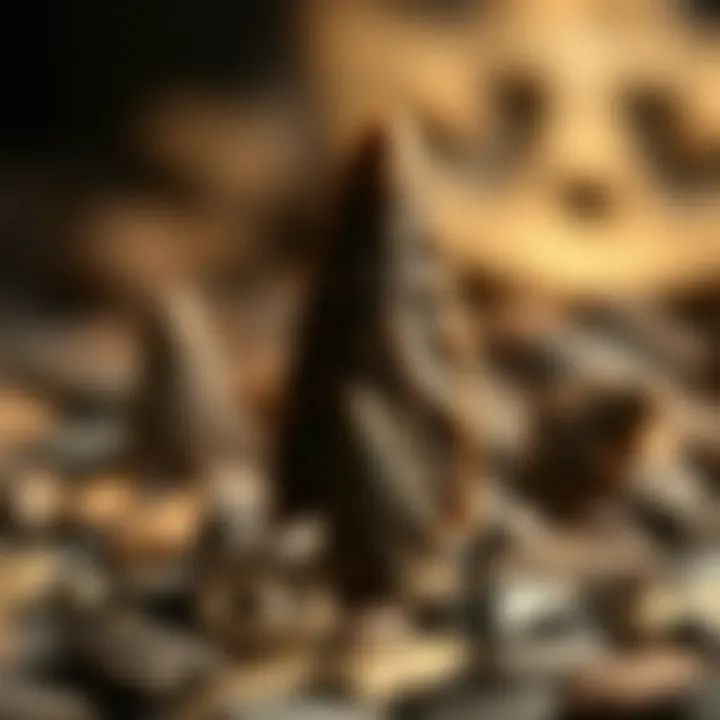
Caring for and Preserving Arrowheads
Caring for and preserving arrowheads is a crucial aspect of collecting that cannot be neglected. As much as the thrill lies in discovering these historical artifacts, safeguarding them for future generations holds equal significance. Arrowheads, especially the valuable ones, can hold extraordinary stories about cultures, technology, and the environment. Proper care not only helps in maintaining their physical appearance but also ensures that they retain their historical integrity. Collectors should regard arrowheads as a bridge to the past, deserving of thoughtful attention and careful preservation.
Cleaning Techniques
When it comes to cleaning arrowheads, a careful approach is paramount. Harsh chemicals or abrasive materials can easily damage these artifacts. Here are some effective methods for cleaning:
- Gentle Rinsing: For minor dirt and grime, rinsing your arrowheads with warm water and a soft brush can do the trick. A toothbrush with soft bristles works well to avoid scratches while still enabling you to clean effectively.
- Soaking: In cases where dirt is more stubborn, soaking the arrowhead in distilled water for a few hours can help loosen debris. Importantly, don’t soak too long, as extended exposure can weaken adhesives that may be present from prior repairs.
- Sensitivity to Materials: If the arrowhead is made from softer stones like obsidian or flint, refrain from using anything abrasive. A soft cloth or chamois can provide a gentler touch for the final polish.
"Proper cleaning respects the story an arrowhead carries, ensuring that each piece retains its identity throughout generations."
Storage Solutions
Once cleaned, the next goal is effective storage. Proper storage protects arrowheads from environmental factors like humidity, temperature fluctuations, and physical damage. Here are a few recommended storage methods:
- Acid-Free Containers: Utilize acid-free materials, such as cardboard boxes or museum-quality display cases. This helps prevent chemical reactions that can lead to degradation.
- Individual Pouches: Keeping each arrowhead in its own padded pouch made from soft materials prevents scratches and holds up against potential abrasions.
- Climate Control: Store the collection in a controlled environment, if possible. Avoiding basements or attics can save arrowheads from exposure to dampness or extreme heat, which might warp or crack them over time.
The Role of Community in Collecting
The world of arrowhead collecting is not merely about acquiring artifacts. It extends far beyond individual interests, embracing a vibrant community of enthusiasts who share a common passion. The role of community in this field is paramount as it nurtures connections, exchanges knowledge, and provides opportunities for collectors to unite over their shared goals and aspirations. From informal gatherings to organized clubs, the sense of camaraderie among collectors serves as the backbone of this fascinating hobby.
One of the standout aspects of the community is its ability to foster learning and growth for both newcomers and seasoned collectors alike. Those who join local clubs often find their understanding of arrowheads deepens through shared experiences and expertise. The excitement of discovering unique finds is often only rivaled by the stories shared within these groups. Engaging with fellow enthusiasts can help identify integral aspects that might easily go unnoticed, whether it's the context of a certain design or subtle nuances in craftsmanship.
Additionally, these clubs often organize events, such as field trips or shows, where members can buy, sell, or trade arrowheads. This face-to-face interaction adds a personal touch to the transactions that online platforms may lack. Online platforms have inundated the market, but local clubs encourage authentic connections, establishing trust and respect among collectors that runs deeper than mere transactions.
Local Collecting Clubs
Local collecting clubs serve as the heartbeat of the arrowhead community. These organizations often come together to promote education, preservation, and enjoyment of Native American artifacts. Typically, members range from casual hobbyists to serious collectors, creating a diverse environment where various levels of expertise converge.
Participating in these clubs offers several benefits:
- Networking opportunities: Members can share leads on rare finds, attend workshops, and even connect with dealers or experts in the field.
- Knowledge exchange: Regular meetings often feature guest speakers or presentations covering various aspects of arrowhead collecting, from historical significance to preservation techniques.
- Community events: Clubs frequently organize local fairs or exhibitions showcasing members' collections, providing a platform for showcasing personal treasures.
Many clubs can be found across the United States and can often be located through platforms such as Facebook or regional heritage organizations. They frequently welcome newcomers, emphasizing the importance of inclusion and education, making it easier for people to immerse themselves in the world of arrowhead collecting.
Forums and Online Groups
In addition to local clubs, the rise of digital communication has birthed numerous forums and online groups dedicated to arrowhead enthusiasts. These platforms provide a virtual space for discussions, advice, and sharing finds from all over the globe. Many collectors find these forums a convenient way to connect and learn without geographical limitations.
Some notable online spaces include:
- Reddit: With a dedicated subreddit for arrowheads, collectors can post their finds, ask for advice, and engage in discussions with like-minded individuals.
- Facebook Groups: Multiple groups cater specifically to arrowhead collectors, enabling members to share photos, arrange trades, and exchange tips seamlessly.
- Dedicated Websites: Various websites and forums allow collectors to engage, trade, and even learn from historical articles or guides related to arrowheads.
The beauty of online groups lies in the sheer diversity of their members, offering global perspectives on arrowhead collecting. This connectedness creates a sense of belonging that transcends individual experiences, making it clear that, while each collector has their unique journey, they all share an appreciation for the art of arrowhead craftsmanship.
"Collecting arrowheads is more than just a hobby; it’s about community, history, and the thrill of the hunt."
The harmony of local clubs and online forums enriches the arrowhead collecting experience, making the journey just as exciting as the artifacts themselves. Whether in community halls or on digital screens, the role of community continues to be an essential thread woven throughout the rich tapestry of this hobby.
Ending
As we wrap up this deep dive into the fascinating world of arrowhead collecting, it's crucial to recognize the significance that the future holds for enthusiasts. The landscape of valuable arrowheads is continually evolving, influenced by both cultural shifts and technological advancements. A likely future trend involves the incorporation of augmented reality to enhance the practice of collecting, allowing for a virtual examination of specimens before purchase. Collectors might find themselves able to explore ancient sites remotely, laying eyes on artifacts that would otherwise remain out of reach.
The Future of Arrowhead Collecting
The dawn of the digital age heralds new opportunities for collectors. Online markets are booming, presenting a varied and broader audience with access to arrowheads that may have once been confined to local collectors. Embracing these platforms can provide numerous benefits, such as:
- Greater access to seek out unique items without geographical constraints.
- The ability to share knowledge and experiences on forums and social media, fostering a vibrant community of enthusiasts.
- Tools for verifying authenticity via advanced imaging technologies or blockchain to trace provenance.
- Collaboration with museums or academic entities, ensuring ethical collecting and preservation methods are prioritized.
This growing community comes with its challenges. For instance, as more people partake in the hunt for these historical gems, the market may see price surges, complicating affordability. Additionally, there is always a looming danger of counterfeits, which produces a pressing need for collectors to stay educated and vigilant.



